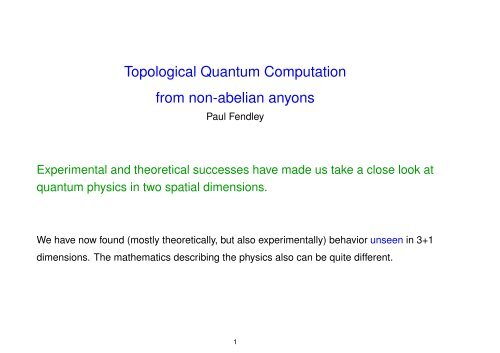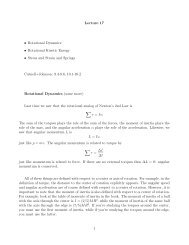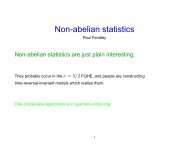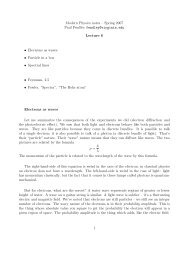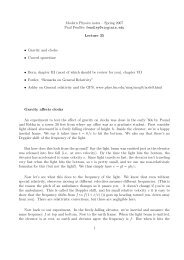Topological Quantum Computation from non-abelian ... - Paul Fendley
Topological Quantum Computation from non-abelian ... - Paul Fendley
Topological Quantum Computation from non-abelian ... - Paul Fendley
You also want an ePaper? Increase the reach of your titles
YUMPU automatically turns print PDFs into web optimized ePapers that Google loves.
<strong>Topological</strong> <strong>Quantum</strong> <strong>Computation</strong><strong>from</strong> <strong>non</strong>-<strong>abelian</strong> anyons<strong>Paul</strong> <strong>Fendley</strong>Experimental and theoretical successes have made us take a close look atquantum physics in two spatial dimensions.We have now found (mostly theoretically, but also experimentally) behavior unseen in 3+1dimensions. The mathematics describing the physics also can be quite different.1
One potential application of this novel physics is a topological quantum computer.This idea relies on one particularly unusual property possible only in two dimensions:<strong>non</strong>-<strong>abelian</strong> statistics.There are several possibilities for realizing <strong>non</strong>-<strong>abelian</strong> statistics experimentally:• a two-dimensional electron gas in a large magnetic field (the fractional quantum Halleffect);• rapidly rotating Bose-Einstein condensates• frustrated magnets.2
Outline:1. What are <strong>non</strong>-<strong>abelian</strong> statistics?2. What does this have to do with quantum computation?3. What does this have to do with mathematics?The Potts model and the BMW algebra: 2002, with N. Read<strong>Quantum</strong> Potts nets: 2005, with E. FradkinNew classical loop models: 2006; 2008 with J. Jacobsen<strong>Quantum</strong> Potts loop models: 2007; 2008The BMW algebra, the chromatic algebra, and the golden identity: 2007, with V. Krushkal3
A quantum computer is massively parallel: the initial state can be a superposition of everyphone number in the Manhattan phone book.A single unitary transformation acts on all of these at once: could do reverse lookups inorder√N time as opposed to order N .Numbers could be prime-factored in polynomial time.But with every silver lining.... . .6
Errors!In a classical computer, just be redundant.In a quantum computer, errors are continuous, not just bit flips. Moreover, measurementdestroys the superposition. How do we know errors have occurred?!? Need to preserve+αIt’s <strong>non</strong>-trivial to show that error correction is even possible for quantum computers.7
The idea behind a topological quantum computer to exploit systems with quantumredundancy.In particular, in 2+1 dimensions, identical particles can have some very strikingproperties.8
In three dimensions, the only statistics for identical particles are bosonic and fermionic:ψ(x 1 , x 2 , . . . ) = ±ψ(x 2 , x 1 , . . . )Exchanging twice is a closed loop in configuration space.01010101x 1x 2In three dimensions, this can be adiabatically deformed to the identity.9
In 2+1 dimensions, the statistics comes <strong>from</strong> behavior under braiding. Each particletraces out a worldline in time, and these braid around each other.figure <strong>from</strong> Skjeltorp et alBraiding is a purely topological property.11
Even more spectacular phenomena than anyons can occur under braiding.Particles can change quantum numbers!ψ a (x 1 , x 2 . . . ) = ∑ B ab ψ b (x 2 , x 1 . . . )When the matrix B is diagonal with entries ±1, particles are bosons and fermions.When B is diagonal with entries e iα , particles are anyons.When B is not diagonal, can get <strong>non</strong>-<strong>abelian</strong> statistics.With <strong>non</strong>-<strong>abelian</strong> statistics, the probability amplitude changesdepending on the order in which the particles are braided.12
Braiding particles with <strong>non</strong>-<strong>abelian</strong> statistics entangles them!This is the fundamental idea behind topological quantumcomputation.Kitaev; excellent review in Preskill’s lecture notes13
We need to understand fusion: what are the statistics of a pair of particles?This is <strong>non</strong>-trivial even for <strong>abelian</strong> anyons. Say we have two identical particles which pickup a phase e iα when exchanged, or equivalently, e 2iα under a 2π rotation of one aroundthe other. Then a pair of these picks a phase e 8iα when exchanged with different pair.In the <strong>non</strong>-<strong>abelian</strong> case, fusing two particles can give a linear combination of states,analogous toin SU(2).12 ⊗ 1 2 = 0 + 114
The simplest kind of <strong>non</strong>-<strong>abelian</strong> statistics is in the braiding of Fibonacci anyons.Fusing two Fibonacci anyons gives a linear combination of a single Fibonacci anyon(denoted φ) and a state with trivial statistics (denoted 1). They satisfy the fusion ruleφ × φ ∼ 1 + φThis is like the tensor product of two spin-1 representations if we throw out the spin-2piece.The consistency rules governing braiding and fusing of anyons are identical to those of2d rational conformal field theory. These are known as the Moore-Seiberg axioms for auniversal modular tensor category.15
φ × φ = I + φPrecise meaning in field theory: The operator product expansion of two φ fields containsboth the identity field I and the field φ itself .Precise meaning in conformal field theory: the “fusion coefficients” for the primary fields Iand φ are N I φφ = N φ φφ = 1.Precise meaning for this talk: There are two possible quantum states for two Fibonaccianyons. One has trivial statistics, the other has the braiding properties of a singleFibonacci anyon.16
This fusion algebra allows us to count the number of quantum states for 2Nquasiparticles:1 : I1 : φ2 : φ × φ = I + φ3 : φ × φ × φ = I + φ + φ5 : φ × φ × φ × φ = φ + 2(I + φ)8 : φ × φ × φ × φ × φ = 3I + 5φThe number of states for n particles is the nth Fibonacci number.17
To make a qubit requires 4 Fibonacci anyons. There are two different ways of fusingthese four into an overall identity channel – the two states of a qubit!Namely, when the overall channel is I, when the combination of anyons 1 and 2 fuses tostate φ, then anyons 3 and 4 must also be in the state φ. If anyons 1 and 2 fuse to I,then anyons 3 and 4 must also fuse to I.The system can be in any linear combination of these two states. We can change thestate, by braiding particle 2 around particle 3.This entanglement is possible even if <strong>non</strong>e of the particles are near each other!18
This is why <strong>non</strong>-<strong>abelian</strong> statistics allow a fault-tolerant quantum computer.The braiding of particle 2 with particle 3 allows us to do quantum computation. The resultof this braiding depends only on the topological properties of the system: these particlescan be very far <strong>from</strong> each other.No local perturbation will change the results of the braiding.19
One can find the braiding and fusing matrices <strong>from</strong> standard conformal field theorytechniques.For example, for four Fibonacci anyons in overall channel I,B = 1 τ⎛⎝ e4πi/5 −e 2πi/5√ τ−e 2πi/5√ τ −1⎞⎠where τ = 2 cos(π/5) = (1 + √ 5)/2 is the golden mean.However, a much more intuitive and instructive way to study <strong>non</strong>-<strong>abelian</strong> braiding in depthis to use algebras and draw pictures!20
We project the world lines of the particles onto the plane. Then the braids becomeovercrossings and undercrossingsThe braids must satisfy the consistency condition=which in closely related contexts is called the Yang-Baxter equation.21
A simple way of satisfying the consistency conditions leads to the Jones polynomial inknot theory. Replace the braid with the linear combination= q1/2 1/2q1/2= q q 1/2so that the lines no longer cross. q is a parameter which is a root of unity in the cases ofinterest: the Fibonacci case corresponds to q = e iπ/5 .22
This gives a representation of the braid group if the resulting loops satisfy d-isotopy.• isotopy: Configurations related by deforming without making any lines cross receivethe same weight.• d: A configuration with a closed loop receives weightd = q + q −1relative to the configuration without the loop.23
These relations can all be treated in terms of the Temperley-Lieb algebra, whichgraphically is= d=This is usually written in terms of generators e i acting on the ith and i + 1st stands:e 2 i = de ie i e i±1 e i = e i24
To ensure finite-dimensional representations of this algebra, needwith k a positive integer.d = 2 cos[π/(k + 2)] i.e. q = e iπ/(k+2)This is related to SU(2) k Chern-Simons theory. In this topological field theory, allphysical quantities follow <strong>from</strong> topological data (how the loops link with each other).Witten25
The problem: find a quantum Hamiltonian acting on a two-dimensional Hilbert spacewhich has the above properties.26
One answer:Fig. 1, Pan et al0.5T e~ 4 mK2SampleR xy(h/e 2 )0.48/35/27/335/21.00.38/3 7/3R xx(kΩ)19/713/5 12/516/73.2 3.4 3.6 3.8 4.0 4.2 0.0MAGNETIC FIELD [T]27
The leading candidate wavefunction for the ν = 5/2 plateau is the Moore-Read Pfaffian,which contains <strong>non</strong>-<strong>abelian</strong> anyons with d = √ 2.A closely-related theory describes the superconductor with p x + ip y pairing, believed tobe realized in strontium ruthenate. The vortices here are <strong>non</strong>-<strong>abelian</strong> anyons.28
Another idea:Much effort has been devoted to constructing quantum loop models whose quasiparticleshave <strong>abelian</strong> and <strong>non</strong>-<strong>abelian</strong> braiding.Such models are closely related to frustrated magnets, and there is hope that they can berealized in the lab, in what are often known as spin-liquid phases.29
A (hopefully not unique) procedure to construct such a quantum loop model is1. find a 2d classical loop model which has a critical point2. use each loop configuration as a basis element of the quantum Hilbert space3. use a Rokhsar-Kivelson Hamiltonian to make the quantum ground state a sum overloop configurations with the appropriate weighting.Kitaev; Moessner and Sondhi; FreedmanThe inner product must be topological, i.e. 〈a|b〉 depends only on topological data.Levin; <strong>Fendley</strong>30
To realize this form of braiding, each loop in the ground state gets a weight d (= τ forFibonacci)i.e. the ground state is the sum over all loop configurations|g.s.〉 = ∑ Ld n L |L〉where n L is the number of loops in configuration L.31
The excitations with <strong>non</strong>-<strong>abelian</strong> braiding are defects in the sea of loops.When the defects are deconfined, they will braid with each other like the loops in theground state.Kitaev; Freedman32
To find a quantum loop model which has Fibonacci anyons, one needs to overcomeseveral technical obstacles: the d = √ 2 barrier, and finding a topological inner product.These both end up being solved by allowing “loops” to branch, so the degrees of freedomare best called nets.A very exciting mathematical byproduct is that using quantum topology we find newalgebraic proofs of the golden identity for the chromatic polynomial. We also find manygeneralizations.33
These nets can be described using the SO(3) Birman-Murakami-Wenzl algebra:1= qq= qq1Here the lines are “spin-1” versions of the “spin-1/2” Temperley-Lieb lines. Note there are3 possibilities on the right, i.e. 1 ⊗ 1 = 0 ⊕ 1 ⊕ 2.34
The generalization of d-isotopy for spin-1 lines depends on a parameterQ = q + q −1 + 1. Graphically, it is= Q1=(Q 1)= (Q 2) +plus a three-strand relation.To get Fibonacci anyons, one still has q = e πi/5 , so closed loops still get weightQ − 1 = q + q −1 = τ .35
Such loops satisfy a property understood long before BMW, or even Temperley-Lieb.Weights obeying this generalization of d-isotopy have have exactly the same propertiesas the chromatic polynomial χ Q .When Q is an integer, χ Q is the number of coloring each region with Q colors such thatadjacent regions have different colors. For Q not an integer, the chromatic polynomialχ Q is defined recursively via the contraction-deletion relation.1233323322Think of these loops as domain walls in the low-temperature expansion of the Q-statePotts model.36
The chromatic algebra satisfies<strong>Fendley</strong> and Krushkal1. d-isotopy with closed <strong>non</strong>-intersecting loops getting a weight Q − 1.2. Tadpoles get vanishing weight.= 03. Crossings can be rewritten in terms of pairs of trivalent vertices (or vice versa) via=+=+37
We find models with deconfined Fibonacci anyons by exploiting a miracle called thegolden identity.Tutte 1969For branching lines on the sphere with only trivalent vertices:χ τ+2 = τ + 2τ 4 τ 3N tri/2 ( χ τ+1) 2where N tri is the number of trivalent vertices.Incidentally, this identity gives a 3.618.. color theorem.38
Graphically,= τ 3/2The two types of blue line (solid and dashed) are independent.Physically, this means that the weight of each domain-wall configuration in the thelow-temperature expansion of the Potts model with Q = τ + 2 = (5 + √ 5)/2 is thesquare of the weight of the same configuration in the Potts model with Q = τ + 1 (andtimes an extra weight per vertex).39
This allows construction of a quantum “loop” model with <strong>non</strong>-<strong>abelian</strong> braiding, thequantum Potts net.<strong>Fendley</strong> and Fradkin; Fidkowski, Freedman, Nayak, Walker and Wang; see also Levin and WenThe degrees of freedom are branching nets with only trivalent vertices allowed, e.g.One creates two Fibonacci anyons by cutting one of the strands, i.e. each anyoncorresponds to the end of a strand.40
The new proof of the golden identity using quantum topology exploits the chromaticalgebra plus two special properties valid at special values of Q.1. The Jones-Wenzl projector exists when q is a root of unity. When q = e iπ/5 , i.e.Q = τ + 1, setting it to zero givesτ =+This can be viewed as an identity for chromatic polynomials.41
2. Level-rank duality: Here we exploit O(3) 4 ↔ O(4) 3 , and the fact that as algebrasO(4) = O(3) × O(3).= =τ+1= τ2=τ + τ − −Each type (solid and dashed) of blue line behaves as a independent <strong>non</strong>-crossingloop! Each loop receives a weight d = τ .The golden identity can now be proved by drawing pictures!42
Conclusions• New identities for the chromatic polynomial can be derived using the Jones-Wenzlprojector when Q = 2 + 2 cos(2πj/(k + 2)) and j ≤ k are positive integers. Forj = 1, these are the Beraha numbers.• Models with <strong>non</strong>-<strong>abelian</strong> braiding have been constructed. Because they are gapped,there is hope that they might be realized in frustrated magnets.• <strong>Topological</strong> quantum computation is not likely in the near future, but you never know...43


